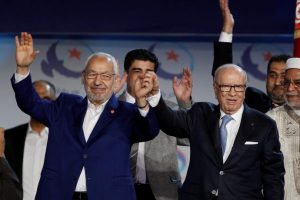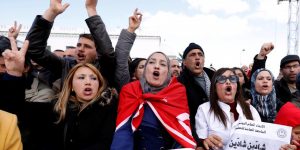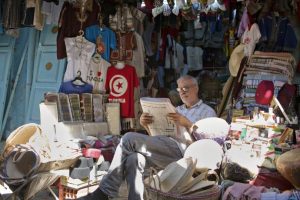The story of how the Tunisian revolution began is well known. On December 17, 2010, a 26-year-old fruit vendor named Mohamed Bouazizi from the town of Sidi Bouzid set himself on fire outside a local government building. The man’s self-immolation—an act of protest against repeated mistreatment by police and local officials—sparked protests that quickly spread across the country. Within a few weeks, President Zine el-Abidine Ben Ali had stepped down and fled the country after 23 years in power, offering Tunisia an unprecedented opportunity for a democratic opening. A massive wave of uprisings soon swept the country’s neighbors, reaching all the way to the Levant and the Persian Gulf.
Less well known is what happened inside Tunisia next. Even though the country had become ground zero of the Arab Spring, its transition was quickly overshadowed by events in more populous Arab countries with deeper ties to the United States and more patently cruel rulers. But nearly a decade on, Tunisia remains the only success story to have come out of the many uprisings. Across the Arab world, countries that looked as though they might follow in its footsteps have become mired in civil war, as has happened in Libya, Syria, and Yemen. Others, such as Bahrain and Egypt, have returned to repression and authoritarianism. Tunisia, by contrast, has drafted a progressive constitution and held free and fair elections at the presidential, parliamentary and local levels. In July, when President Beji Caid Essebsi died at the age of 92, the transition to a caretaker government was smooth and unremarkable. Several problems persist and continue to hobble the country, in particular a long track record of economic mismanagement and a disconcerting lack of trust in public institutions. But for all the unfinished business Tunisia still faces, its example remains a source of hope across the region.
In achieving this feat, Tunisia has helped dispel the myth that Arab societies or Islam is not compatible with democracy. But the country’s story also offers lessons for beyond the Arab world: that transitions from authoritarianism require brave leaders willing to put country above politics and that such transitions are by nature chaotic and halting. For the international community, this means that states in transition should be offered the diplomatic and, above all, financial support they need to bear the growing pains of democracy and come away with as few scars as possible.
AFTERSHOCKS OF REVOLUTION
Postrevolutionary Tunisia inherited a state in disrepair. The Ben Ali regime had been notoriously corrupt. It plundered the country’s public coffers and stashed the money in bank accounts belonging to Ben Ali’s wife, Leila Trabelsi, and her family. The government favored certain coastal regions, neglecting the south and the interior of the country, from where the revolution would later emerge. Political competition was nonexistent, and potential challengers to Ben Ali’s ruling party, the Democratic Constitutional Rally, were either banned outright or forced to operate under restrictions so severe as to permanently keep them on the sidelines. Those who ran afoul of the regime were imprisoned and tortured.
Postrevolutionary Tunisia inherited a state in disrepair.
Leaving this dismal record behind was not easy, and in the first years after Ben Ali’s ouster, the country endured serious setbacks. Debates on the role of religion in public life were particularly divisive. Ben Ali’s regime had prided itself on its secular and progressive approach to women’s rights in a country where 99 percent of the population is Sunni Muslim. When a popular Islamist political movement, Ennahda, emerged in the 1980s, Ben Ali promptly banned it and imprisoned or exiled tens of thousands of its members. But when Tunisians voted for a constituent assembly to draft a new, postrevolutionary constitution in the fall of 2011—the country’s first-ever democratic election—Ennahda received the most votes of any party, setting up a fierce fight over the direction the transition. Among the most contentious issues was women’s standing in civic and political life. For Ennahda, women were “complementary” to men—but that term angered non-Islamists, who feared that writing it into the constitution would open a back door to gender discrimination. The critics eventually prevailed. But the constitution-drafting process had exposed painful cleavages within Tunisian society.
Ennahda’s win in the 2011 election allowed it to form a three-way governing alliance with two smaller, secular parties, imposing a semblance of order on the postrevolutionary chaos. But beneath the surface, the situation remained unstable, in part because many secularists were as afraid of Ennahda’s Islamist agenda as they were of a return to authoritarianism. In 2013, frustration with the Ennahda-led government culminated in a national crisis. In February of that year, Islamist extremists murdered the prominent leftist opposition leader Chokri Belaid. The assassination sparked mass protests, with many accusing the government of standing by in the face of violent extremism. The Tunisian General Labor Union, or UGTT, called its first general strike since 1978, bringing the country to a standstill for days. When another leftist leader, Mohamed Brahmi, was assassinated a few months later, more large-scale demonstrations followed. Protesters were now calling for the Constituent Assembly to dissolve.
The turmoil of 2013 could have easily derailed the entire transition process. That it did not was largely due to the work of four powerful civil society organizations—the UGTT, the country’s bar association, its largest employers’ association, and a human rights group—which came together for talks in the summer of 2013. The National Dialogue Quartet, as the group came to be known, represented constituencies with widely differing interests, but its members soon agreed on a path forward, calling for a new electoral law, a new prime minister and cabinet, and the adoption of the long-delayed constitution. It then mediated a national dialogue among the major political parties. The talks convinced Ennahda to step down and brought a new, technocratic government to power. The Quartet also helped the Constituent Assembly resolve sticking points in the new constitution, and in January 2014, the deputies passed the new text in a near-unanimous vote.
It would not be the last time that coalition building allowed postrevolutionary Tunisia to weather a moment of uncertainty. In late 2014, the country held its first-ever free parliamentary and presidential elections. The contest was fair, but turnout—48 percent of eligible voters for the legislative and 45 percent for the presidential election—was low for such a monumental event, suggesting that Tunisia was not the vibrant democracy many had hoped for. And the results seemed to set Tunisia up for further conflict. Essebsi, the presidential candidate with the most votes, was a staunch secularist and longtime member of the pre-revolutionary regime who had run on an explicitly anti-Ennahda platform. His party, Nidaa Tounes, was a loose coalition of non-Islamist parties and activists united in their opposition to the Islamist group and little else.
Essebsi therefore took Islamists and secularists alike by surprise when, shortly after the election, he formed a coalition with Ennahda. Essebsi, it soon emerged, had been meeting for secret talks with the Ennahda leader Rached Ghannouchi, a remarkable development, given that Essebsi had served as foreign minister under the regime that had imprisoned and tortured Ghannouchi. Their public rapprochement sent a powerful message to the public: the days of bitter political rivalries were in the past. A democratic Tunisia could accommodate leaders of all stripes—Islamists and secularists, conservatives and liberals.

Violent extremism, however, still punctuated the country’s progress. Terrorist attacks in early 2015, first at the National Bardo Museum, in downtown Tunis, and later at a beach resort in Sousse, killed a total of 60 people, most of them European tourists. The attacks were a significant blow to Tunisia’s tourism industry, which makes up around eight percent of the country’s GDP. They also shed light on the severity of Tunisia’s problem with Islamist fundamentalism. The chaos of the early transition years had made it difficult for the Tunisian government to clamp down on the recruitment of extremists, particularly in the country’s traditionally marginalized interior. And as democracy flourished without providing real change to the lives of Tunisians—the economy remained stagnant and unemployment high—many felt they had nothing to lose by joining the ranks of extremist groups. By 2015, Tunisia was infamous for being both the sole democracy in the Arab world and the top exporter to Iraq and Syria of foreign fighters for the Islamic State, or ISIS.
As the region’s only democracy, Tunisia is a target for jihadi terrorism.
To make matters worse, Tunisia shared a porous border with Libya, where a chaotic civil war had allowed ISIS to flourish. Without much hassle, Tunisian citizens could cross into Libya, train in ISIS camps there, and return to Tunisia to carry out attacks at home—as the perpetrators of the Bardo and Sousse attacks had done. To this day, extremists also hide out on the other side of the country, in the mountainous border area between Tunisia and Algeria, from where they periodically carry out small-scale attacks against Tunisian security forces. Thanks largely to Western assistance, the Tunisian state has greatly improved its counterterrorism capabilities. But as the region’s only democracy, Tunisia has a target painted on its back. This past summer, both al Qaeda and ISIS called for fighters to refocus their attention on the country.
Foreign assistance has helped the country in a number of areas, including counterterrorism, but it bears emphasizing that the main drive for change came from within. Before 2011, U.S. ties with Tunisia were as good as nonexistent. U.S. President Barack Obama came to power seeking a new beginning with the Muslim world and made clear that, unlike his predecessor, he had no intention of imposing democracy on the Arab world. But when grassroots-led democratic movements swept the region, the Obama administration was determined to protect them, at least initially. It threw its weight behind the protests, both rhetorically and financially. U.S. Secretary of State Hillary Clinton visited Tunisia less than two months after Ben Ali’s departure to emphasize U.S. support for the transition. U.S. bilateral assistance to Tunisia jumped from $15 million in 2009 to $26 million in 2011. Multilateral programs provided several hundred million dollars more, bringing the U.S. total to over $1.4 billion since 2011. (The Trump administration has tried to make dramatic cuts in each of its proposed budgets, in line with its effort to slash foreign aid globally, but consistent congressional support has kept aid for Tunisia steady.) The European Union and its member states also upped their support in the years following the revolution, providing $2.65 billion between 2011 and 2017.
Despite that assistance, Tunisia still faces several major obstacles. Youth unemployment hovers around 30 percent, and inflation is rising. Since the revolution, the suicide rate has nearly doubled, and close to 100,000 highly educated and skilled workers have left the country. Tunisia recently overtook Eritrea as the country with the largest number of migrants arriving in Italy by sea. To slow this trend and improve Tunisians’ economic prospects, the government will need to take some unpopular measures, such as cutting wages in the public sector. This will require confronting the powerful labor unions—in particular, the UGTT—which at times have effectively shut down the country with massive strikes. But inaction will only turn off international lenders and exacerbate the brain drain, mass emigration, and extremist recruitment.

Reforming sclerotic government institutions is another priority. The judiciary remains largely unreformed. Many judges are holdovers from the Ben Ali era, and the byzantine legal code is not always in line with the constitution. Most egregious, the country currently has no constitutional court, largely because lawmakers cannot agree on whom to appoint as judges. The first democratically elected parliament, in office from 2014 to October 2019, struggled mightily to pass legislation and suffered from severe absenteeism, with around half its members missing in action on any given day.
The most important item on the agenda is regaining the confidence of the Tunisian public. As of early 2019, only 34 percent of Tunisians trusted the president, and only 32 percent trusted their parliament, according to a poll by the International Republican Institute. When it comes to voicing their concerns, many of them, especially the young, prefer the streets over the ballot box. Around 9,000 protests are held each year, the majority of which originate in the same traditionally marginalized regions where the revolution started. This problem has no easy solution, but devolving greater powers to the local level would help. The country’s first-ever local elections, held in May 2018, were a step in the right direction. Not only did they introduce one of the most progressive gender-parity requirements of any electoral law globally, with 47 percent of local council seats going to women; they also opened the gates to young candidates, with 37 percent of the seats going to those under 35.
BUILDING THE SHIP AS IT SAILS
Tunisians are quick to point out that their country doesn’t provide a model that can be cut and pasted onto other national contexts. But their experience still holds important lessons about how to support democracy. For outsiders, the main takeaway is to keep one’s distance at first. Tunisia succeeded thanks not to the presence of a pro-democracy agenda led by other countries but to the absence of such an effort. The transition began with a grassroots call for change, which foreign donors and international partners later stepped in to support. This made it hard for the government to discredit the protests as a foreign-driven, neocolonialist project. Wherever possible, the United States and Europe should allow homegrown change to occur without premature interference. Once democratic transitions take root, outside governments should be quick to offer financial support and training. In places where change seems unlikely to emerge on its own, foreign donors should make use of conditional aid and provide larger pots of funds to countries that meet certain political and economic indicators. The Millennium Challenge Corporation and the European Union’s “more for more” principle, both of which reward countries for political and economic reform, are good examples of this approach.
Young democracies, for their part, can learn from Tunisia’s brand of consensus politics. Tunisia’s transition could well have failed in 2013 had two leaders, Essebsi and Ghannouchi, not put democracy and pluralism ahead of their own political ambitions. Budding democratic leaders are often tempted to fall into autocratic patterns of behavior and promote their own agendas by hoarding power. In the early stages of a democratic transition, however, leaders need to share political space and prioritize pluralism over exclusion, such that once the situation has stabilized, there is enough room for healthy political competition.
Young democracies can learn from Tunisia’s brand of consensus politics. Likewise, democracies in the making should heed the cautionary tale of Tunisia’s gridlocked Constituent Assembly. For its first three years, the new government in Tunis operated without a constitution to guide its actions. And today, almost six years after the constitution’s ratification, much of it has not been implemented. Several of the bodies it mandates, such as a constitutional court, remain to be formed. Tunisia is building the democratic ship as it sails, which has led to public frustration and confusion. Transitioning countries would be well served by clearly establishing the rules of the game from the outset and developing an efficient and realistic timeline for forming the crucial institutions to make democracy work.
There are limits, however, to what one can learn from Tunisia. In particular, its experience offers no satisfying answer about how to sequence political and economic reforms. Leaders in Tunis chose to focus first on political renewal, drafting a new constitution, holding elections, and creating political institutions. Doing so has left the economy moribund—and the country with a broken social contract. For many Tunisians, the new regime has not delivered the dignity they demanded in 2010, and as a result, the public distrusts the new democratic institutions. But trying to fix the economy before taking on the challenge of political reform could have backfired, too. There was no guarantee that once the economy improved, transitional leaders would have remained committed to democratic reform. Ultimately, economic challenges are inevitable during democratic transitions, and the only viable solution may be for outsiders to provide a stronger safety net through loan guarantees, budget support, and foreign direct investment in the hope of maintaining public support for democracy.
Tunisia is a beacon of hope for pro-democracy movements across the Middle East, but even for the region’s many autocrats, the country’s successful democratic transition is more than just a cautionary tale—for there are worse fortunes they could face. Ben Ali’s forced retirement in Saudi Arabia may not strike them as enviable—but it must certainly seem preferable to the fates of some who refused to bow out, be it death at the hands of insurgents (Libya’s Muammar al-Qaddafi); seeing one’s country be plunged into years of civil war, devastation, and economic disaster (Syria’s Bashar al-Assad); or both (Yemen’s Ali Abdullah Saleh). These divergent fortunes will loom large in the minds of rulers if they are faced with mass protests today. As for the region’s many activists, Tunisia offers a safe haven that is far more accessible than Europe or the United States—and an example of Arab democracy to emulat

